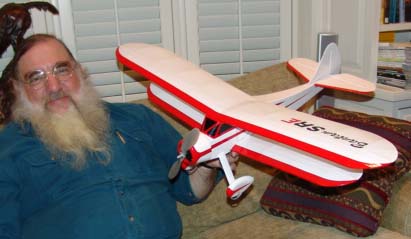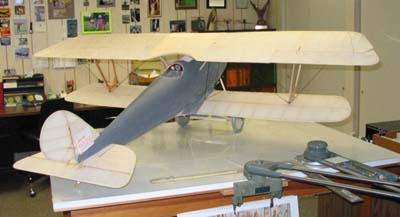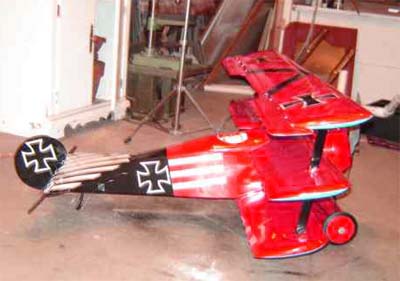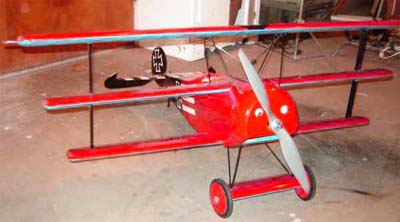 |
Flying High With Electric Power!
The Ampeer ON-LINE!
Fly the Future - Fly Electric! |
Site Table of Contents
| President: | Vice-President: | Secretary/Treasurer: |
| Ken Myers | Richard Utkan | Rick Sawicki |
| 5256 Wildcat | 240 Cabinet | 5089 Ledgewood Ct. W. |
| Croswell, MI 48422 | Milford, MI 48381 | Commerce Twp., MI 48382 |
| (810) 679-3238 | (248) 685-1705 | 248.685.7056 |
 | ||
| Board of Directors: | Board of Directors: | Ampeer Editor |
| David Stacer | Jack Lemon | Ken Myers |
| 16575 Brookland Blvd. | 8908 Sandy Ridge Dr. | 5256 Wildcat Rd. |
| Northville, MI 48167 | White Lake, MI 48386 | Croswell, MI 48422 |
| 248.924.2324 | 248.698.4683 | 810.679.3238 |
| Mailed Ampeer subscriptions are $10 a year US & Canada and $17 a year world wide. FREE on-line! | ||
| The Next Meeting: Date: Thursday, January 5 Time: 7:30 p.m. Place Rick Sawicki's house | ||
|
From Taking Care of Your Battery Series By Shawn Palmer, Marketing/Support Dir., support@castlecreations.com, 785-883-4519 Reprinted with permission of the author Welcome to the first of a series of articles exploring some of the "black science" issues of R/C, where we explain in understandable terms some of the most common technical questions, as well as dispel some of the common myths surrounding R/C electronics.
Shawn Palmer,
The December EFO Meeting The December meeting was held on Thursday, December 8, a day that southeastern Michigan got dumped on with 6" Š 8" of snow that evening! While the attendance was slim, it was a very good meeting.
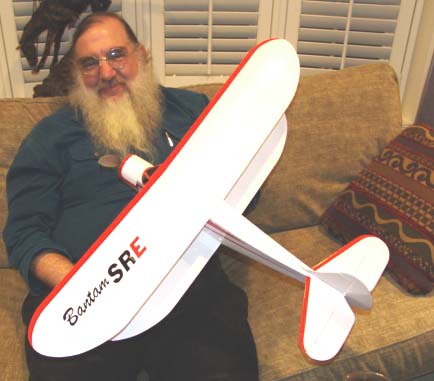
Camille Goudeseune's review of the Air Hogs' Aero Ace in the December 2005 Ampeer inspired EFO VP Richard Utkan to purchase one and give it a try. Richard reported that it does live up to exactly what Camille had to say about it. It is a lot of fun for a little price. 
Richard with Air Hog Dave Stacer shared his built up Flutter B. He's built a lot of flat foam planes recently, and thought it was time to give a built up plane a go. It is fitted with one of his self-wound CD-Rom motors and has the front end modified a bit for better battery pack carrying. 
Dave with Flutter-B Rick Sawicki shared his latest electric control line, a Smoothie. It is powered by an AXI 2826-10, 3S1P PolyQuest "Twenty" Li-Po and swings a 12x6 prop. Rick is absolutely thrilled with the new "Twenty" series Polyquest cells and says they deliver much higher voltages under the current draw he uses than anything else he has used. He says the Smoothie is a great flier and enjoys flying it very much. 
Rick with Smoothie (photo taken at Midwest RC Society meeting KM The members present thank Rick for his great hospitality and we are looking forward to a better-attended January meeting. See you all then and bring in your latest projects and electric flight gizmos. AXI_Calc
Thought I'd share this with you. I've downloaded it to the PC and it seems quite interesting. KM Dear Ken, I know you by the web and the sites you manage (+ D-Calc group). I suggest to you, if you have time, try my small freeware AXI_Calc program.
Best regards
Some Planes in Progress I recently heard from Louis Dionne, who is now living in Ottawa. He caught me up on what he's been doing and sent along a couple of photos of a 60" Pfalz DIIIA that he has under construction. He credits his friend Walter with most of the work. 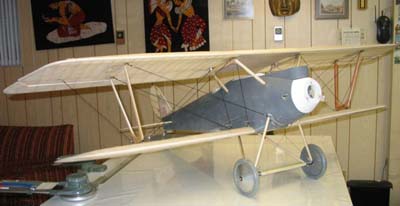
From Walt Thyng of Illinois we have some photos of his Fokker Tripe in progress. Here's what he had to say about this project: Here are some interim photos of my latest project. The color registration is poor in the photos. (I tweaked it a bit, so that it looks redder. KM) The red is Red Baron red not orange. I still have to do the dummy engine, find some Spandaus or figure out how to build them, add the pilot and build custom motor pack. Power will be an Astro 40G on 20 P3000s.
More later,
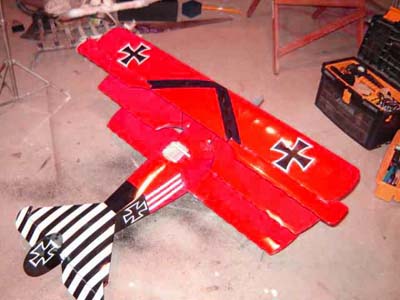
Serendipity, Again!
As many of you know, 2005 was an "interesting year" for me. Having moved four times in the last year was an interesting experience! My modeling life, as well, has been one of constantly finding out new things.
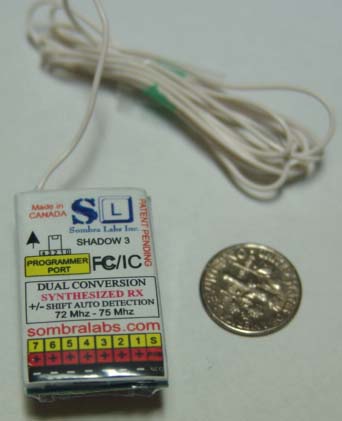 Just after the beginning of the year, I started designing my first, very own design, sport-scale plane. Things were going quite well, until I built a model of the proposed wing using foam board and found out the wheels, when retracted, weren't going to fit into the wing. I rescaled the design in my CAD program, rebuilt the wing section model, and the gear will fit in the slightly larger size version. |
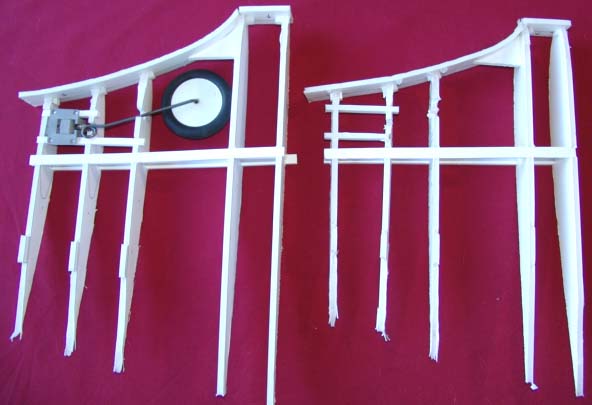
|
I tried bending the new landing gear using my K&S wire bender, but it just wouldn't do the job. I ordered a new wire bender from Hobby Lobby. They call it "Best Wire Bender". It is part number HLH704 and sells for $25.90. The amazing thing is that it is the best wire bender that I have ever used. I highly recommend it! |

|
With the design well under way, it was time to test my brand-new, year-and-a-half old, AXI 2820/10, as that was the motor I was planning on using in the plane. See the August 2005 Ampeer for details on how well that went! Not!
June found me with two broken planes. Both from very freak accidents. Things hadn't happened like this to me in years.
The questionable AXI was put into the Tiger Shark (my own design sport plane) as it was repaired and then flown. The AXI 2820/10 gave up the ghost after four flights. I'll be taking it out of the Tiger Shark soon, and seeing how good Hobby Lobby's exchange policy really is.
Regards,
Therefore, my two "new" props are actually "old" versions of this prop.
Thick 11.11v, RPM-7965, Amps-26
While this doesn't seem like a huge difference, note the RPM for each and note the difference in amps. Now think about what is going to happen as these props each exceed 10,000 RPM.
"Hi Ken, Here's how it works. Ke = volts peak per 1000rpm.
Kv is the inverse of Ke, so Kv = 1/.8746 = 1.1433 krpm/vpk = 1143 rpm/vpk. Vpk = the DC bus voltage from the batteries so that the unloaded rpm at any applied voltage can be calculated.
Regards,
All through the month of August I was in almost daily contact with Phil and Rob. We shared some very interesting emails, and they put up with some very stupid statements by me. We did find that the prop constants and prop factors used by the Emeter need some finer "tweaking", and that is in the works.
I looked at the data, again, on the aircraft-world.com site for the Z3019-10 and realized that for the 10" and above props, Dave had used fairly flat pitches. This led me to once again choose the wrong motor for the job. Dave used a power supply to get his data. I had mistakenly looked at the data for the APC 11x5.5E and guessed wrong as to what the APC 11x7E would do! For a more realistic "guess", I should have looked at the APC 12x6E, but even then, my "real world" data for the Z3019-10 does not come close to matching what Dave at Aircraft World measured. His measurements are way under what I measured. If I had to guess, I'd guess he used the "old" APC "E" props. It just gets harder and harder for me to chose the correct motor for the job.
YAK-54's
Dick had written to me about a YAK-54 that he was converting to electric power. I sent off an email to see if I could get an update on the project. Here's his very sad tale. KM Not too sure what you have on file, but here's a recap to date. This is over about the past 6 months, and 4 Yaks later. | |||||||||||||||||||||||||||||||||||||||||||||||||||||||||||||||||||||||||||||||||||||||||||||||||||||||||

|
My 72" Quiqie Somenzini Signature Series Yak went together like a dream. It took only about 10 days to do the conversion, and get it ready to maiden. On a Sunday morning I got it all ready and hit the runway. My son-in-Law took it off and it flew like a Yak should. Stable as a rock, not a click of trim. I thought that it could use a bit more power. I planned on going up to a 20" prop.
|
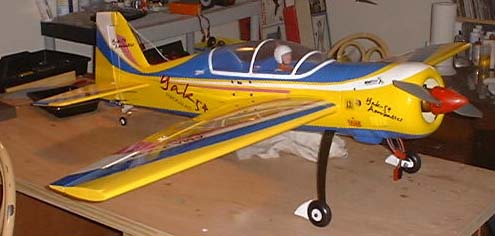
|
So I ordered another of the Fiberglass Yak's and it is now waiting to be Maidened. They are a nice little plane, although there is no way that can it be brought in at the weight they say on the box. But it flies very well at 6.8 pounds on the AXI 4120/14 with 4S-2P 6000 MAH pack. The instructions are a bit hard to follow, but enough to get it built. It comes with everything needed to build the model, and for the price is a good buy.
Wishing you and yours a Merry Christmas and a most prosperous and Happy New Year Dick Corby |
More on Future Lithium Polymer Battery Systems Just as I was finishing up this issue, I received an email from Dave Manley of Lenexa, KS. I'm not quoting all of his email here, except for a few points that I thought were interesting, as well as my response to Dave. "Okay, I'm a wuss, but I just can't bring myself to give safe harbor to lithium polymer. I'm such a wuss that I prefer to charge my Ni-cads and nickel-metal packs when I'm awake. I'm beginning to feel like an old fossil. Well, I am an old fossil, but you get the point. What are your club mates flying? Is anybody still in the Ni-cad mode?" "Hi Dave, I too have remained in the safe harbor of NiCads and NiMH. We are definitely on the cusp of having much safer Lithium technology. I had purchased, some time last year, an Astro Flight 109 charger and a Kokam 3S1P 2100mAh Li-Po pack. The pack didn't come with taps, so I just got it back from Keith, who added some taps so that I could read each cell and balance them.
Later,
Pitts Conversion Suggestion Ken, I have a Hyperion Z3019-10 that needs a home, so I'm thinking of this possible conversion. Thought I'd share it with you. Herr Pitts Special Kit: 300 sq.in. 
Est. Completed Airframe Weight (CAW): 19 oz.
 ESC: Hyperion Titan 30A ESC 1.06 oz. Battery: MaxAmps 2S1P 2100mAh Li-Po 4.55 oz. Receiver: FMA M5v2 Sub Micro Rx 0.3 oz. Servos: 3 Hitec HS-81 servos: 1.76 oz. Systems total: 12.67 oz. w/fudge factor: 13.3 oz. Ready to Fly (RTF) weight: 32.3 oz. Wing loading: 15.5 oz./sq.ft. Cubic wing loading: 10.7 oz./cu.ft. Expected performance with an APC 10x7E: 7374 RPM, 23.5 amps, 7.44v, 175 watts in, eff. 80.9%, Pitch Speed 49 MPH |
To Reach Ken Myers, you can land mail to the address at the top of the page. My E-mail
address is:
KMyersEFO@mac.com
EFO WEBsite: http://members.aol.com/KMyersEFO/
